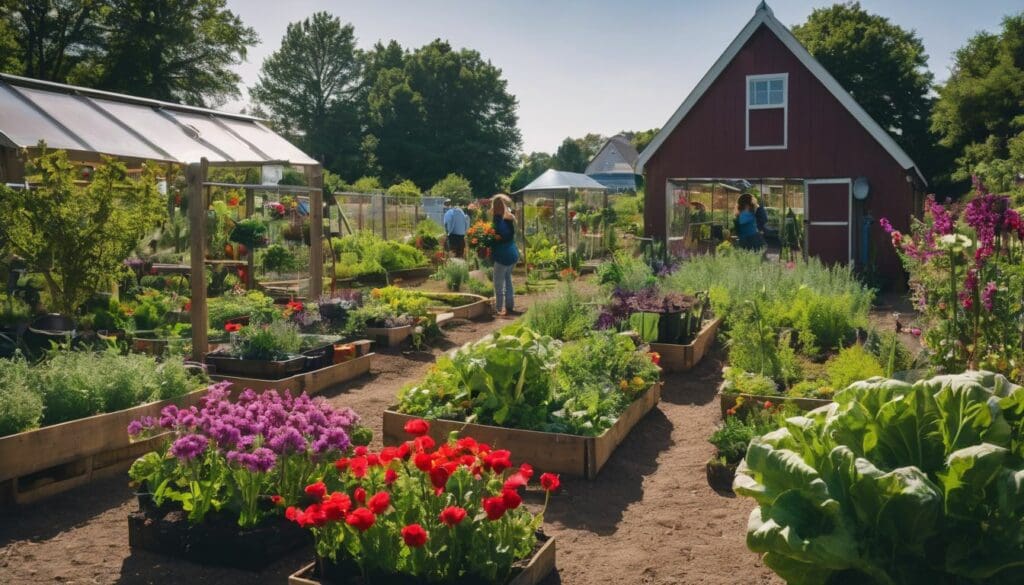In today’s relentless hustle and bustle, the quest for a tranquil spot of green amidst our urban sprawl can feel like searching for a needle in a haystack. We’ve all experienced that deep-seated craving to escape into nature without leaving the confines of our city limits.
It was this very desire that propelled us to explore the myriad advantages concealed within community gardens. Our odyssey has shone a light on how these communal patches not only inject life into neighbourhoods but also knit together stronger bonds of camaraderie, bolster well-being, and cultivate a spirit of stewardship towards our environment.
Let us take you by the hand and meander through this verdant voyage!
Key Takeaways
- Community gardens are shared spaces that bring people together to grow fresh produce, enhancing both physical health and community connections.
- These gardens help reduce environmental impact by promoting local food growth, reducing carbon emissions from transport, and increasing biodiversity.
- Taking part in community gardening activities can improve mental well – being and create strong bonds between neighbours through shared goals and experiences.
- By engaging with a community garden, individuals contribute to sustainable agriculture practices and environmental conservation within urban areas.
- Accessing nutritious foods grown locally supports healthy eating habits while fostering a sense of accomplishment as communities work together for the betterment of their environment.
What are Community Gardens?
Community gardens are shared green spaces where members of a community come together to grow and maintain fruits, vegetables, and flowers. These spaces can be found in urban areas and help to strengthen community connections while promoting sustainable living practices.
Definition
Community gardens are shared green spaces where we come together to grow fruits, vegetables, herbs, and flowers. They embody sustainable living by allowing neighbours to cultivate fresh produce while fostering social cohesion within urban and suburban areas.
These gardens represent more than just plots of land; they’re a movement towards food security, environmental stewardship, and healthier lifestyles.
We engage in collective gardening in these spaces not only for the health benefits but also as an initiative for public health improvement. Moving beyond their definition leads us into exploring their purpose – why do we invest our time and energy into these patches of cultivated earth?.
Purpose
Community gardens serve a vital purpose in promoting sustainable agriculture and enhancing the quality of life within our neighbourhoods. By providing access to fresh produce, these gardens support healthy eating initiatives and encourage nutritious food choices, thereby contributing to improved physical health for all participants.
Additionally, actively engaging in gardening fosters physical activity and mental well-being, offering an opportunity for community members to connect with nature while nurturing their local environment.
Furthermore, neighbourhood gardens play a crucial role in urban agriculture and sustainable food production, thus reducing environmental impact and supporting the local food movement.
Benefits of Community Gardens
Community gardens offer numerous benefits, including improving physical health by providing access to fresh produce and encouraging outdoor activity. They also promote community building and create opportunities for environmental impact reduction through sustainable gardening practices.
Physical Health
Community gardens are a great way to improve our physical health. The fresh produce grown in these communal spaces provides us with nutritious, organic fruits and vegetables that support our overall well-being.
By encouraging regular outdoor activity, community gardens also help to promote a healthy lifestyle and reduce the risk of various health issues.
Engaging in gardening activities can contribute to increased physical activity levels, which helps maintain a healthy weight and reduces the likelihood of obesity-related conditions such as diabetes and heart disease.
Community Building
Improving health through community gardens fosters stronger bonds among neighbours. Working together to grow fresh, nutritious produce promotes a sense of unity and shared purpose.
Engaging in gardening activities enhances mental well-being as individuals forge connections with others who share their passion for sustainable living and healthy eating.
Encouraging community involvement in public health initiatives alongside environmental conservation efforts can lead to meaningful change within neighbourhoods. By participating in these green spaces, residents contribute to the overall enhancement of their local environment while simultaneously building a flourishing, interconnected community.
Environmental Impact
Community gardens have a positive impact on the environment by reducing the carbon footprint. By growing food locally, we decrease the need for long-distance transportation and storage, leading to lower greenhouse gas emissions.
Additionally, community gardens promote biodiversity by providing habitats for various plant species and attracting beneficial insects. These green spaces also improve soil health through composting and natural fertilisers, contributing to sustainable agricultural practices that conserve our natural resources.
Furthermore, community gardens play a significant role in reducing urban heat islands by adding greenery to built-up areas. This helps lower temperatures in cities and mitigates the effects of climate change.
Conclusion
In conclusion, community gardens offer a place for neighbors to come together and create a sense of unity. They provide access to fresh produce, promoting better nutrition and physical health.
Community gardens also contribute towards mental well-being and engagement within the neighborhood. The impact of these green spaces goes far beyond individual plots – they foster stronger communities committed to environmental stewardship.
FAQs
1. What are the benefits of community gardens for neighbors?
Community gardens offer neighbors a place to grow fresh nutrition-rich foods and provide mental health benefits through gardening activities.
2. Can community gardens improve our eating habits?
Yes, participating in community gardens can lead to better nutrition by providing access to fresh produce and encouraging healthier eating habits.
3. How do community gardens help with mental health?
Working in a garden has been shown to ease stress and promote relaxation, leading to significant mental health benefits for those involved.
4. Do community gardens make neighborhoods more united?
Definitely! Community engagement flourishes in garden spaces where neighbors work together, share resources, and bond over shared tasks.





